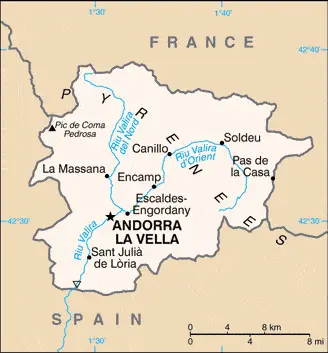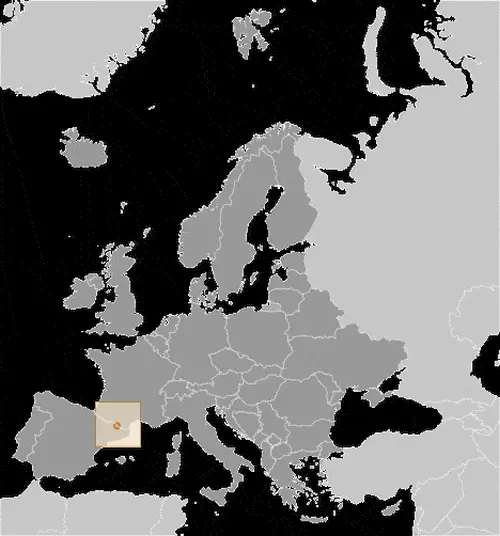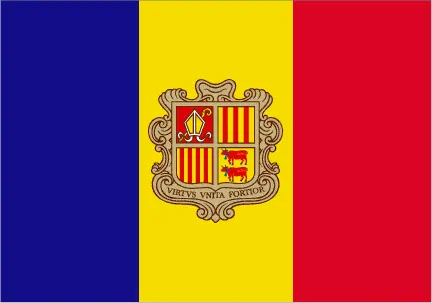Google Maps and detailed facts about Andorra (AD). This page lets you explore Andorra and its border countries (Country Location: Southwestern Europe, Pyrenees mountains, on the border between France and Spain) through detailed Satellite imagery – fast and easy as never before Google Maps.
Find comprehensive information about this country’s diversity below: Google maps, geography, economy, science, people, culture, environment, government, and history – All in One Wiki page.
There is also a Street View and free Driving Directions at your service. Your Google Satellite Map Sightseeing in Andorra, Europe, starts here at Driving Directions and Maps.com.
Table of contents
- Background
- Overview
- Google Maps
- Climate
- Geography
- Resources and Land Use
- Population Data
- Economic Data
- Drinking Water Source
- Population, Median Age, Migration, and Citizenship
- Average Number of Childbirths
- Is this country a Safe Destination?
- Healthcare and Infectious Diseases
- Natural Hazards
- The Flag and Other Symbols
- Constitution
- Legal System
- About the Unemployment Rate, Labor Force, and Poverty Line
- About the Budget and Central Government Debt
- Inflation Rate and Prime Lending Rate
- Export/Import Partners and Data
- Renewable Energies Used
- Telecommunication Data, Calling Code
- Transport Infrastructure
- More Interesting Facts
Background
Andorra’s history is deeply rooted in its strategic position in the Pyrenees, initially established as a buffer state by Charlemagne in the 8th century. For centuries, it was co-ruled by French and Spanish leaders until a modern constitution in 1993 transformed it into a parliamentary democracy while retaining its unique co-principality status. This small European state, nestled between France and Spain, has become a popular tourist destination known for its ski resorts, mild summers, and duty-free shopping. Despite not being an EU member, Andorra enjoys a special relationship with the union, using the euro as its currency.
Overview
Andorra is one of the smallest states in Europe, characterized by a high GDP and a strong tourism sector. Its economy, which faced challenges due to the COVID-19 pandemic, is undergoing modernization with efforts to attract foreign investment and diversify beyond tourism and banking.
Official Name: Principality of Andorra
Date of Formation: 1278 (Co-principality), Modern Constitution in 1993
Capital: Andorra la Vella
Population: Approximately 85,468 (2023 estimate)
Total Area: N/A
Population Density: N/A
Languages: Catalan (official), French, Portuguese, Spanish
Religions: Predominantly Roman Catholic
Ethnic Origin: Andorran, Spanish, French, Portuguese
Government: Parliamentary Democracy (Co-principality)
Currency: Euro (EUR)
Literacy Rate: N/A
Calorie Consumption: N/A
Andorra Google Maps
A tiny landlocked principality, Andorra lies high in the eastern Pyrenees between France and Spain. It held its first full elections in 1993. Tourism is the main source of income. With six deep, glaciated valleys, high mountains drain into the Valira River as it flows into Spain.
Located in the Pyrenees mountains, Andorra’s geographical beauty and urban centers can be explored via Google Maps. The map below shows Andorra’s cities, towns, highways, main roads, streets, and Street Views. To find a location, use the form below, type any city or place, view a simple map, and click the “show map” button.
The Google map above shows Andorra’s location: Europe (geographic coordinates: 42 30 N, 1 30 E) and the international borders of Andorra; total: 118 km. Border countries (total: 2): France 55 km, Spain 63 km; furthermore, it’s inland counties boundaries.
The map of Andorra, Europe, is for informational use only. No representation is made or warrantied given any map or its content by Driving Directions and Maps site. The user assumes all risks of using this Andorra Google map and facts/wiki.
Climate
Andorra’s climate, characterized by its temperate conditions, is influenced by its location in the eastern Pyrenees mountains. This setting results in distinct seasonal changes, with cold, snowy winters and warm, dry summers, making it an attractive destination for various activities throughout the year. Here’s an extended overview of Andorra’s climatic conditions, incorporating factual and interesting aspects:
- Mountain Climate Influence: Andorra’s high elevation and mountainous terrain significantly influence its climate. The country’s average elevation is about 1,996 meters (6,549 feet), contributing to cooler temperatures, especially in the higher altitudes.
- Snowy Winters: Winters in Andorra are cold and snowy, ideal for winter sports. The snow season typically starts in December and can last until April. The country’s ski resorts, such as Grandvalira and Vallnord, are popular destinations for skiing and snowboarding enthusiasts.
- Average Winter Temperatures: During winter, temperatures in Andorra can vary but often hover around -2 °C to 6°C (28°F to 43°F). The coldest months are usually January and February. The high altitude of the ski resorts means they can experience even lower temperatures.
- Warm, Dry Summers: Summers in Andorra are generally warm and dry, with temperatures ranging from 20°C to 30°C (68°F to 86°F). This pleasant weather is ideal for hiking, mountain biking, and other outdoor activities in the Pyrenees.
- Rainfall Patterns: Andorra receives most of its rainfall in the spring and autumn. The average annual precipitation is about 1,000 mm (39 inches), varying depending on the altitude and area. Thunderstorms are common in the summer months.
- Microclimates: Due to its mountainous terrain, Andorra has several microclimates. Valleys can have milder weather than higher mountain areas, where the climate is harsher and temperature variations are more pronounced.
- Sunshine Hours: Despite its high altitude, Andorra enjoys much sunshine throughout the year. The country receives about 2,500 hours of sunshine annually, with the sunniest summer months.
- Climate Change Impact: Like many mountainous regions, Andorra is experiencing the effects of climate change. This includes changes in snowfall patterns, which can impact winter sports, and an increased risk of natural hazards such as landslides and floods.
- Vegetation and Climate Zones: The climate in Andorra supports a variety of vegetation zones. Mountain pine forests characterize lower elevations, while higher altitudes have alpine meadows. The changing seasons offer diverse landscapes, from snow-covered peaks in winter to lush green valleys in summer.
- Environmental Conservation: Andorra is actively involved in environmental conservation efforts, particularly in managing its forested areas and preserving the natural beauty of the Pyrenees. This is crucial for maintaining the country’s climate and biodiversity.
Andorra’s temperate climate, with its distinct seasonal variations, significantly shapes the country’s natural beauty and outdoor recreational activities. Understanding these climatic conditions is essential for sustainable tourism and environmental conservation in this mountainous region.
Geography
Andorra’s geography is indeed dominated by its mountainous terrain, which is a defining characteristic of this small, landlocked country nestled in the eastern Pyrenees mountains. Here’s an extended overview of Andorra’s geographical features, including more detailed statistics and information about its neighboring countries:
- Mountainous Terrain: Andorra is largely covered by the Pyrenees mountains. This rugged terrain shapes much of the country’s landscape, contributing to its scenic beauty and making it popular for winter sports and hiking.
- Highest Point – Pic de Coma Pedrosa: The highest peak in Andorra is Pic de Coma Pedrosa, which reaches an elevation of 2,946 meters (9,662 feet). This peak is part of the larger Pyrenees mountain range and is a popular destination for hikers and mountaineers.
- Lowest Point – Riu Runer: The lowest point in Andorra is the Riu Runer, which is at an elevation of 840 meters (2,756 feet). This point is located near the border with Spain, where the Gran Valira River exits the country.
- Mean Elevation: With a mean elevation of 1,996 meters (6,549 feet), Andorra is one of the highest countries in Europe. This high average elevation is due to the country being located entirely in the Pyrenees.
- Narrow Valleys: Between the mountain peaks are narrow valleys that crisscross the country. These valleys are home to Andorra’s towns and villages and are where most of the population lives. The valleys also provide important routes for roads and trails.
- Rivers and Lakes: Andorra has several small rivers and streams, most of which are tributaries of the Valira River, the country’s main watercourse. Numerous mountain lakes, known as “estanys,” are also popular for fishing and scenic beauty.
- Surrounding Countries:
- Spain: To the south, Andorra shares a border with Spain. This border is approximately 63.7 kilometers (39.6 miles) long and is predominantly mountainous, featuring some of the highest peaks in the Pyrenees.
- France: To the north, Andorra’s border with France stretches about 56.6 kilometers (35.2 miles). Like the border with Spain, it is characterized by high mountain terrain and is a natural barrier between the two countries.
- Climate Influence: The geography of Andorra, particularly its high elevation and mountainous terrain, significantly influences its climate. The country experiences a temperate climate with snowy winters and warm summers, ideal for both winter and summer outdoor activities.
- Biodiversity: The varied terrain and climate of Andorra support a diverse range of flora and fauna. The country’s forests, rivers, and high mountain meadows are home to various wildlife, including several species of birds, mammals, and plants.
- Natural Resources: Andorra’s natural resources include hydroelectric power, mineral water, timber, iron ore, and lead. The country’s mountainous terrain is also a key resource, supporting its tourism industry, particularly for skiing and hiking.
Andorra’s geography, with its high mountains and narrow valleys, not only defines its natural beauty and outdoor recreational opportunities but also influences its culture and way of life. The country’s position in the Pyrenees and its borders with Spain and France make it an important location for understanding the geography and culture of this region of Europe.
Resources and Land Use
Andorra’s natural resources include hydropower, mineral water, timber, iron ore, and lead. About 40% of the land is agricultural, with 1.7% arable.
Population Data
The population of Andorra is approximately 85,468 as of 2023, concentrated mainly in its seven urbanized valleys.
Economic Data
With a real GDP of $3.327 billion (2015 estimate), Andorra’s economy is primarily driven by tourism, banking, and its status as a duty-free area. The real GDP growth rate was 8.95% in 2021.
Drinking Water Source
Access to improved drinking water sources is available to 100% of Andorra’s population.
Population, Median Age, Migration, and Citizenship
Andorra’s median age is 48.1 years (estimated for 2023), with a stable net migration rate of 0 migrants/1,000 population (estimated for 2023).
Average Number of Childbirths
The total fertility rate in Andorra is 1.46 children born per woman (estimated to be 2023).
Is this country a Safe Destination?
Andorra is generally considered a very safe tourist destination, with low crime rates and a peaceful environment.
Healthcare and Infectious Diseases
The country has a well-developed healthcare system, spending 9.1% of its GDP on health (2020 estimate) and a physician density of 3.63 physicians/1,000 population (2015).
Natural Hazards
The primary natural hazard in Andorra is avalanches, particularly in the mountainous regions during winter.
The Flag and Other Symbols
Andorra’s flag consists of three vertical bands of blue, yellow, and red, with the national coat of arms in the yellow band. The coat of arms features emblems representing its historical ties with Urgell, Foix, Bearn, and Catalonia.
Constitution
Adopted in 1993, Andorra’s constitution transitioned the country into a modern parliamentary democracy while maintaining its co-principality status.
Legal System
Andorra has a mixed civil, customary, and canon (religious) legal system.
About the Unemployment Rate, Labor Force, and Poverty Line
The unemployment rate in Andorra was 3.7% in 2016, reflecting a robust economy and job market.
About the Budget and Central Government Debt
Andorra’s public debt was 41% of its GDP in 2014, with budget revenues of $1.872 billion against expenditures of $2.06 billion in 2016.
Inflation Rate and Prime Lending Rate
The inflation rate in Andorra was -0.9% in 2015, indicating a stable economic price level.
Export/Import Partners and Data
Major export partners include Spain, France, and the United States, with key exports being integrated circuits and cars. Imports primarily come from Spain and France, including cars and refined petroleum.
Renewable Energies Used
Data on renewable energies used in Andorra are N/A.
Telecommunication Data, Calling Code
Andorra has a modern telecommunications system with a country code of +376. It is well connected with France and Spain through microwave radio relay connections.
Transport Infrastructure
Andorra has a total of 320 km of roadways, with no railways or airports due to its mountainous terrain.
More Interesting Facts
Andorra is known for its beautiful landscapes, ski resorts, and a unique blend of Catalan culture with French and Spanish influences. It’s a haven for shoppers due to its duty-free status and offers a variety of outdoor activities year-round.
Did You Know?
- One of the Smallest Countries: Andorra is the sixth smallest nation in Europe, with an area of just 468 square kilometers (181 square miles). Despite its size, it boasts a rich cultural and historical heritage.
- High Life Expectancy: Andorra has one of the highest life expectancies in the world, often ranking in the top five globally. The average life expectancy is around 83 years, attributed to its clean mountain air and high quality of life.
- No Official Army: Andorra is one of the few countries in the world without an official army. Since signing a peace treaty with France and Spain in the 13th century, it has enjoyed a long history of peace and relies on its neighbors for defense.
- A Co-Principality: Andorra is the only co-principality in the world. It is headed by two co-princes – the President of France and the Bishop of Urgell in Spain. This unique form of government dates back centuries.
- Language: The official language of Andorra is Catalan, making it the only country in the world to have Catalan as its sole official language. However, Spanish, French, and Portuguese are also widely spoken due to its location and tourism.
- A Popular Ski Destination: With its Pyrenean mountains, Andorra is a popular destination for skiing and snowboarding. It has several high-quality ski resorts, such as Grandvalira and Vallnord, which attract winter sports enthusiasts worldwide.
- Tobacco Economy: Historically, tobacco was a major part of Andorra’s economy. The country was known for its high-quality tobacco products, and even today, tobacco farming remains a significant industry.
- No Airports or Trains: Andorra has no airports or train stations. The nearest airports are in Spain and France. The country is well-connected by road, with scenic drives through the Pyrenees.
- UNESCO World Heritage Site: The Madriu-Perafita-Claror Valley in Andorra is a UNESCO World Heritage Site. This glacial valley covers about 10% of the country’s territory, is a haven for rare flora and fauna, and is a site of historical significance.
- Ancient Churches and Architecture: Andorra is home to over 40 Romanesque churches and chapels, some dating back to the 11th century. These structures are renowned for their simple yet elegant design and often feature beautiful frescoes and wooden carvings.
- Duty-Free Shopping: The country is known for its duty-free shopping, attracting visitors from neighboring France and Spain. Andorra la Vella, the capital, is particularly popular for its range of goods and competitive prices.
- Cultural Festivals: Andorra hosts various cultural festivals throughout the year, celebrating everything from jazz music to traditional Andorran folklore. These events showcase the country’s rich cultural diversity and heritage.
These facts about Andorra reveal a country that, despite its small size, is rich in history, culture, and natural beauty, offering a unique blend of modernity and tradition in the heart of the Pyrenees.
Many thanks for visiting and sharing this map & country information site!



